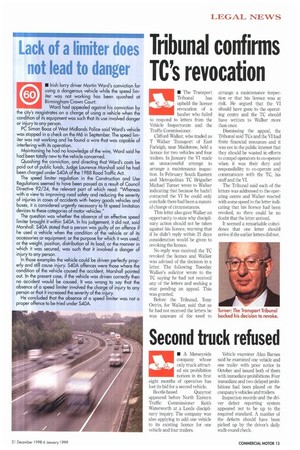Lack of a limiter does not lead to danger
Page 15

If you've noticed an error in this article please click here to report it so we can fix it.
• Irish lorry driver Martin Ward's conviction for using a dangerous vehicle while the speed limiter was not working has been quashed at Birmingham Crown Court. Wand had appealed against his conviction by the city's magistrates on a charge of using a vehicle when the condition of its equipment was such that its use involved danger or injury to any person. PC Simon Boaz of West Midlands Police said Ward's vehicle was stopped in a check on the M6 in September. The speed limiter was not working and he found a wire that was capable of interfering with its operation. Maintaining he had no knowledge of the wire, Ward said he had been totally new to the vehicle concerned. Quashing the conviction, and directing that Ward's costs be paid out of public funds, Judge Laurence Marshall said he had been charged under S40A of the 1988 Road Traffic Act. The speed limiter regulation in the Construction and Use Regulations seemed to have been passed as a result of Council Directive 92/24, the relevant part of which read: "Whereas with a view to improving road safety and reducing the severity of injuries in cases of accidents with heavy goods vehicles and buses, it is considered urgently necessary to fit speed limitation devices to these categories of motor vehicles."
The question was whether the absence of an effective speed limiter brought it within 540A. In his judgement, it did not, said Marshall. S40A stated that a person was guilty of an offence if he used a vehicle when the condition of the vehicle or of its accessories or equipment; or the purpose for which it was used; or the weight, position., distribution of its load, or the manner in which it was secured, was such that it involved a danger of injury to any person.
In those examples the vehicle could be driven perfectly properly and still cause injury. 540A offences were those where the condition of the vehicle caused the accident, Marshall pointed out. In the present case, if the vehicle was driven correctly then no accident would be caused. It was wrong to say that the absence of a speed limiter involved the charge of injury to any person or that it increased the severity of the injury. He concluded that the absence of a speed limiter was not a proper offence to be tried under 540A.
































































































